SNVS325E January 2005 – January 2016 LM2852
PRODUCTION DATA.
- 1 Features
- 2 Applications
- 3 Description
- 4 Revision History
- 5 Pin Configuration and Functions
- 6 Specifications
- 7 Detailed Description
- 8 Application and Implementation
- 9 Power Supply Recommendations
- 10Layout
- 11Device and Documentation Support
- 12Mechanical, Packaging, and Orderable Information
Package Options
Mechanical Data (Package|Pins)
- PWP|14
Thermal pad, mechanical data (Package|Pins)
- PWP|14
Orderable Information
6 Specifications
6.1 Absolute Maximum Ratings
over operating free-air temperature range (unless otherwise noted)(1)(2)| MIN | MAX | UNIT | ||
|---|---|---|---|---|
| PVIN, AVIN, EN, SNS | 6.5 | V | ||
| Power dissipation | Internally limited | |||
| 14-Pin exposed pad HTSSOP package | Infrared (15 sec) | 220 | °C | |
| Vapor phase (60 sec) | 215 | °C | ||
| Maximum junction temperature | 150 | °C | ||
| Storage temperature, Tstg | −65 | 150 | °C | |
(1) Stresses beyond those listed under Absolute Maximum Ratings may cause permanent damage to the device. These are stress ratings only, which do not imply functional operation of the device at these or any other conditions beyond those indicated under Recommended Operating Conditions. Exposure to absolute-maximum-rated conditions for extended periods may affect device reliability.
(2) If Military/Aerospace specified devices are required, please contact the Texas Instruments Sales Office/ Distributors for availability and specifications.
6.2 ESD Ratings
| VALUE | UNIT | |||
|---|---|---|---|---|
| V(ESD) | Electrostatic discharge | Human-body model (HBM), per ANSI/ESDA/JEDEC JS-001(1) | ±2000 | V |
(1) JEDEC document JEP155 states that 500-V HBM allows safe manufacturing with a standard ESD control process.
6.3 Recommended Operating Conditions
over operating free-air temperature range (unless otherwise noted)| MIN | MAX | UNIT | ||
|---|---|---|---|---|
| PVIN to GND | 1.5 | 5.5 | V | |
| AVIN to GND | 2.85 | 5.5 | V | |
| Junction temperature | −40 | 125 | °C | |
6.4 Thermal Information
| THERMAL METRIC(1) | LM2852 | UNIT | |
|---|---|---|---|
| PWP (HTTSOP) | |||
| 14 PINS | |||
| RθJA | Junction-to-ambient thermal resistance | 39.2 | °C/W |
| RθJC(top) | Junction-to-case (top) thermal resistance | 24.1 | °C/W |
| RθJB | Junction-to-board thermal resistance | 20.1 | °C/W |
| ψJT | Junction-to-top characterization parameter | 0.6 | °C/W |
| ψJB | Junction-to-board characterization parameter | 19.8 | °C/W |
| RθJC(bot) | Junction-to-case (bottom) thermal resistance | 1.7 | °C/W |
(1) For more information about traditional and new thermal metrics, see the Semiconductor and IC Package Thermal Metrics application report.
6.5 Electrical Characteristics
AVIN = PVIN = 5 V unless otherwise indicated under the Test Conditions column. Limits apply over the junction temperature (TJ) range of –40°C to 125°C (unless otherwise noted). Minimum and Maximum limits are ensured through test, design, or statistical correlation. Typical values represent the most likely parametric norm at TJ = 25°C, and are provided for reference purposes only.| PARAMETER | TEST CONDITIONS | MIN | TYP | MAX | UNIT | ||
|---|---|---|---|---|---|---|---|
| SYSTEM PARAMETERS | |||||||
| VOUT | Voltage tolerance(1) |
VOUT = 0.8-V option | 0.782 | 0.818 | V | ||
| VOUT = 1-V option | 0.9775 | 1.0225 | |||||
| VOUT = 1.2-V option | 1.173 | 1.227 | |||||
| VOUT = 1.5-V option | 1.4663 | 1.5337 | |||||
| VOUT = 1.8-V option | 1.7595 | 1.8405 | |||||
| VOUT = 2.5-V option | 2.4437 | 2.5563 | |||||
| VOUT = 3-V option | 2.9325 | 3.0675 | |||||
| VOUT = 3.3-V option | 3.2257 | 3.3743 | |||||
| ΔVOUT/ ΔAVIN | Line regulation(1) | VOUT = 0.8 V, 1 V, 1.2 V, 1.5 V, 1.8 V or 2.5 V, 2.85 V ≤ AVIN ≤ 5.5 V |
TJ = –40°C to 125°C | 0.6% | |||
| TJ = 25°C | 0.2% | ||||||
| VOUT = 3.3 V, 3.5 V ≤ AVIN ≤ 5.5 V |
TJ = –40°C to 125°C | 0.6% | |||||
| TJ = 25°C | 0.2% | ||||||
| ΔVOUT/ΔIO | Load regulation | Normal operation | TJ = 25°C | 8 | mV/A | ||
| VON | UVLO threshold (AVIN) | Rising | TJ = –40°C to 125°C | 2.85 | V | ||
| TJ = 25°C | 2.47 | ||||||
| Falling hysteresis | TJ = –40°C to 125°C | 85 | 210 | mV | |||
| TJ = 25°C | 150 | ||||||
| rDSON-P | PFET ON resistance | Isw = 2 A | TJ = –40°C to 125°C | 140 | mΩ | ||
| TJ = 25°C | 75 | ||||||
| rDSON-N | NFET ON resistance | Isw = 2 A | TJ = –40°C to 125°C | 120 | mΩ | ||
| TJ = 25°C | 55 | ||||||
| RSS | Soft-start resistance | TJ = 25°C | 400 | kΩ | |||
| ICL | Peak current limit threshold | LM2852X | TJ = –40°C to 125°C | 2.75 | 4.95 | A | |
| TJ = 25°C | 4 | ||||||
| LM2852Y | TJ = –40°C to 125°C | 2.25 | 3.65 | ||||
| TJ = 25°C | 3 | ||||||
| IQ | Operating current | Non-switching | TJ = –40°C to 125°C | 2 | mA | ||
| TJ = 25°C | 0.85 | ||||||
| ISD | Shutdown quiescent current | EN = 0 V | TJ = –40°C to 125°C | 25 | µA | ||
| TJ = 25°C | 10 | ||||||
| RSNS | Sense pin resistance | TJ = 25°C | 400 | kΩ | |||
| PWM | |||||||
| fosc | LM2852X | 1500-kHz option. | TJ = –40°C to 125°C | 1050 | 1825 | kHz | |
| TJ = 25°C | 1500 | ||||||
| LM2852Y | 500-kHz option. | TJ = –40°C to 125°C | 325 | 625 | kHz | ||
| TJ = 25°C | 500 | ||||||
| Drange | Duty cycle | 0% | 100% | ||||
| ENABLE CONTROL(2) | |||||||
| VIH | EN pin minimum high input | 75 | % of AVIN | ||||
| VIL | EN pin maximum low input | 25 | % of AVIN | ||||
| IEN | EN pin pullup current | EN = 0 V | TJ = 25°C | 1.2 | µA | ||
| THERMAL CONTROLS | |||||||
| TSD | TJ for thermal shutdown | TJ = 25°C | 165 | °C | |||
| TSD-HYS | Hysteresis for thermal shutdown | TJ = 25°C | 10 | °C | |||
(1) VOUT measured in a non-switching, closed-loop configuration at the SNS pin.
(2) The enable pin is internally pulled up, so the LM2852 is automatically enabled unless an external enable voltage is applied.
6.6 LM2852Y Typical Characteristics (500 kHz)
 Figure 1. Efficiency vs ILoad VOUT = 1.5 V
Figure 1. Efficiency vs ILoad VOUT = 1.5 V
 Figure 3. Efficiency vs ILoad VOUT = 3.3 V
Figure 3. Efficiency vs ILoad VOUT = 3.3 V
 Figure 2. Efficiency vs ILoad VOUT = 2.5 V
Figure 2. Efficiency vs ILoad VOUT = 2.5 V
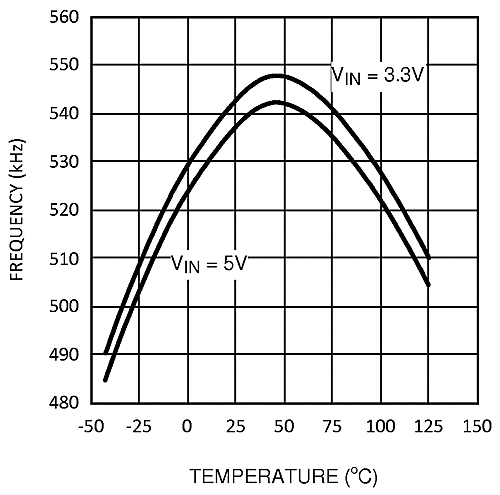 Figure 4. Frequency vs Temperature
Figure 4. Frequency vs Temperature
6.7 LM2852X Typical Characteristics (1500 kHz)
 Figure 5. Efficiency vs ILoad VOUT = 1.5 V
Figure 5. Efficiency vs ILoad VOUT = 1.5 V
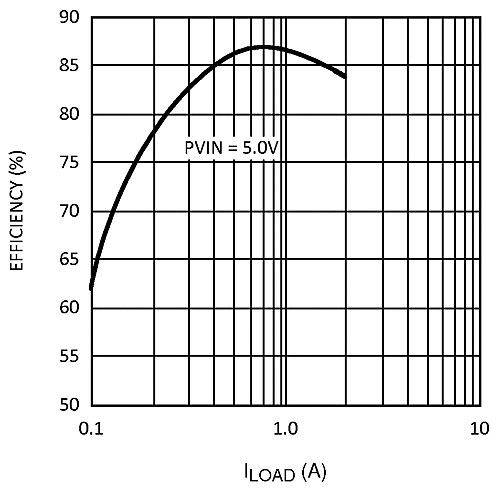 Figure 7. Efficiency vs ILoad VOUT = 3.3 V
Figure 7. Efficiency vs ILoad VOUT = 3.3 V
 Figure 6. Efficiency vs ILoad VOUT = 2.5 V
Figure 6. Efficiency vs ILoad VOUT = 2.5 V
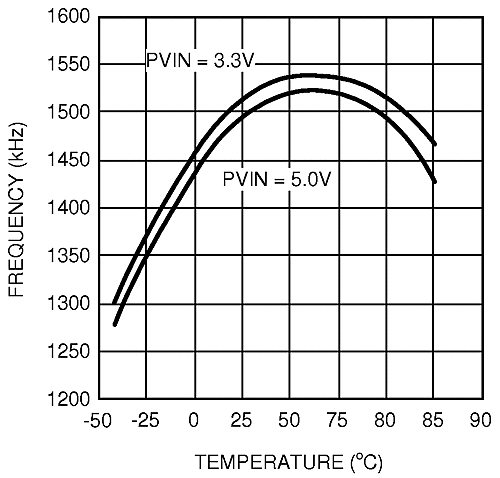 Figure 8. Frequency vs Temperature
Figure 8. Frequency vs Temperature
6.8 LM2852 Typical Characteristics (Both Y and X Versions)
 Figure 9. NMOS Switch RDSON vs Temperature
Figure 9. NMOS Switch RDSON vs Temperature
 Figure 10. PMOS Switch RDSON vs Temperature
Figure 10. PMOS Switch RDSON vs Temperature